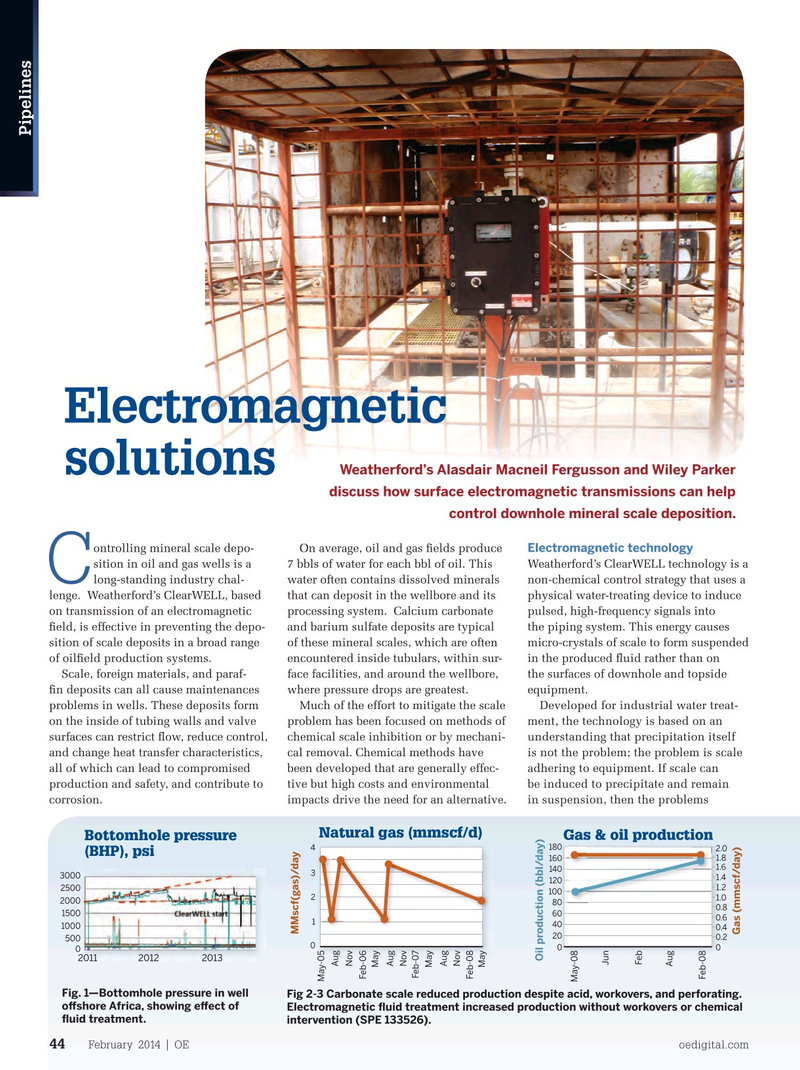
Page 42: of Offshore Engineer Magazine (Feb/Mar 2014)
Read this page in Pdf, Flash or Html5 edition of Feb/Mar 2014 Offshore Engineer Magazine
Pipelines
Electromagnetic
Weatherford’s Alasdair Macneil Fergusson and Wiley Parker solutions discuss how surface electromagnetic transmissions can help control downhole mineral scale deposition. ontrolling mineral scale depo- On average, oil and gas ? elds produce Electromagnetic technology 7 bbls of water for each bbl of oil. This sition in oil and gas wells is a Weatherford’s ClearWELL technology is a
C water often contains dissolved minerals long-standing industry chal- non-chemical control strategy that uses a that can deposit in the wellbore and its lenge. Weatherford’s ClearWELL, based physical water-treating device to induce processing system. Calcium carbonate on transmission of an electromagnetic pulsed, high-frequency signals into and barium sulfate deposits are typical ? eld, is effective in preventing the depo- the piping system. This energy causes of these mineral scales, which are often sition of scale deposits in a broad range micro-crystals of scale to form suspended encountered inside tubulars, within sur- of oil? eld production systems. in the produced ? uid rather than on face facilities, and around the wellbore, Scale, foreign materials, and paraf- the surfaces of downhole and topside where pressure drops are greatest. ? n deposits can all cause maintenances equipment.
Much of the effort to mitigate the scale problems in wells. These deposits form Developed for industrial water treat- problem has been focused on methods of on the inside of tubing walls and valve ment, the technology is based on an chemical scale inhibition or by mechani- surfaces can restrict ? ow, reduce control, understanding that precipitation itself cal removal. Chemical methods have and change heat transfer characteristics, is not the problem; the problem is scale been developed that are generally effec- all of which can lead to compromised adhering to equipment. If scale can tive but high costs and environmental production and safety, and contribute to be induced to precipitate and remain impacts drive the need for an alternative. corrosion. in suspension, then the problems
Natural gas (mmscf/d)
Bottomhole pressure Gas & oil production 180 4 2.0 (BHP), psi 160 1.8 1.6 140 3 3000 1.4 120 1.2 2500 100 2 1.0 2000 80 0.8 1500 60 0.6 1 40 1000 0.4
MMscf(gas)/day
Gas (mmscf/day) 20 0.2 500 0 0 0 0 20112012 2013
Oil production (bbl/day)
Feb
Jun
Nov
Nov
Nov
Aug
Aug
Aug
Aug
May
May
May
Feb-07
Feb-08
Feb-06
Feb-08
May-05
May-08
Fig. 1—Bottomhole pressure in well Fig 2-3 Carbonate scale reduced production despite acid, workovers, and perforating. o

 41
41

 43
43